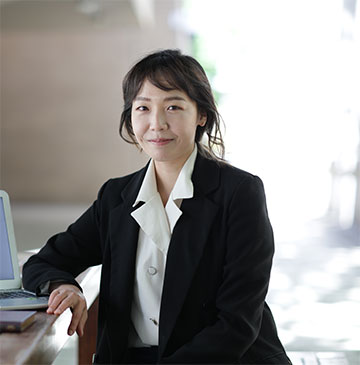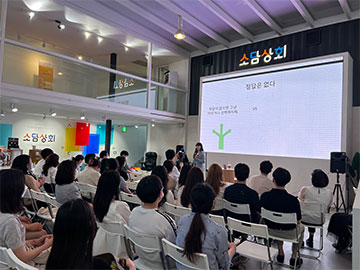
Sejeong Kim [Image: Courtesy of S. Kim]
Things I Wish I Knew Before Graduate School 2, which hit the book market in the Republic of Korea in May 2022, is a sequel to a popular 2019 book that offers advice to STEM undergraduate and graduate students as well as postdocs. One of the sequel’s three authors is Optica Member Sejeong Kim, a lecturer at the University of Melbourne, Australia, chair of the Optica nanophotonics technical group and 2022 winner of Optica Kaminow Outstanding Early Career Professional Prize.
Writing the book wasn’t something that Kim planned to do. Sure, she read the original—written by three men—and thought the book could have used a female voice. But having never written a book before, Kim didn’t think she would (or should) be that voice.
One faithful night in Fall 2020, however, when Kim was feeling “particularly courageous,” she sent a Facebook message to one of the original authors and asked to be connected with his book publisher. When the publisher was presented with Kim’s idea that she would recruit two more women and write a sequel to the original book, to Kim’s surprise, the publisher said yes within a couple of days.
That is how Kim, along with two other first-time authors, got to write the book. Because Kim was trained to write only journal articles and had never written a book (let alone a non-technical one), she says the book-writing process was a bit scary at first. But with the book’s publication, she knew she could achieve a lifetime goal: becoming a role model to other female researchers.
Time crunches
The sequel’s goal was to cover broader range of viewpoints than the first iteration, Kim says, so the book would resonate with a wider audience. One differentiator was the second edition’s all-woman authorship. Another was looking beyond STEM fields and academia—one of Kim’s co-authors covered the marketing field, while the other talked about her experience finding an industry job at Silicon Valley.
The hardest part of writing a book was the time management, Kim says.
The hardest part of writing a book was the time management, Kim says. She admits that she and her co-authors wrote most of the book close to the deadline, because all of them still needed to keep up with their day jobs as professors and a data scientist. Overall, it took about a year for each author to write their sections, which were later combined into a single manuscript.
The subsequent editing rounds were, tough, too. All three of the authors used jargon, which their editor had to “translate” into plain language. And perhaps because of their lack of writing experience, they initially weren’t too happy how the writing turned out, and thought they could have done better with more time, Kim says.
Advice for students
The book’s 51 chapters extensively cover various aspects of graduate school life, including tips on preparing for exams and dealing with the so-called two-body problem: maintaining long-distance relationships for couples whose work puts them in different cities (or even countries). It also talks more about mental-health side of the graduate students’ lives than the first book did, according to Kim, including such topics as overcoming failure—drawing from the real-life example of all three authors failing their qualifying exams when they were in their Ph.D. programs.
One mistaken belief that Kim tackles in the book is the myth about born geniuses.
One mistaken belief that Kim tackles in the book is the myth about born geniuses. In every physics department, there is always at least one person who seems to have been born with physics knowledge in their head, she says. But Kim had an encounter as an undergraduate that usefully shattered that misconception.
She found that an academically gifted classmate of hers, when she talked to him, could recall the specific page in the textbook on which a specific equation appeared. That made Kim realize that this student studied until he could memorize the entire textbook—which indicated that his physics talent wasn’t innate. It also made her recognize, she says, that she had been using her belief that some are “born geniuses” as an excuse to not try as hard—and that if she put in the long hours of study, she too could academically excel. Kim says that incident led her to ramp up the amount of time she spent studying and to eventually graduate as a valedictorian of her class.
Another point Kim makes in the book is the importance of learning the English language, even as scientists. This may sound so obvious to many, Kim says. But some STEM graduate students in Korea neglect to practice English, thinking that their science will “speak for itself.” That, Kim suggests, could lead to limiting oneself to the job market in one’s home country.
Contemplating the future

Sejeong Kim at a book talk in the Republic of Korea. [Image: Courtesy of S. Kim]
Even early in one’s career, it’s good to think about multiple options that lie ahead, Kim argues. Do you want to go to a graduate school in your country or somewhere else? What about an industry job versus academia? The earlier you contemplate these questions, the more information you will gather, which can inform your career decision. And the more informed you are, the more likely it is that you will enjoy the career of your choosing, she says.
Perhaps more important, Kim suggests, is that it’s OK to choose the path you want to take. People experience tremendous pressure to make “correct” choices—because, at that moment, it feels as if that one move will decide whether you succeed or fail in life. The reality, Kim stresses, is that you do what you can do within each choice. And if you’re determined to live a happy life, the happiness will come to you no matter which path you choose, she says.
Speaking of happiness, Kim argues that it’s another misconception that scientists do—and should—enjoy science 24/7. That mistaken belief leads people to think they are not meant to become scientists when they hit small bumps in the road. The truth, she observes, is that it is impossible to love every moment of science—especially when your experiments go haywire or you fail to understand complicated papers.
It is like Olympic gold-medalist swimmer Rowdy Gaines’ story in the Grit, Kim says. In that book, Gaines tells how he hated swim practices—but his love of other aspects of the sport, such as the feeling of being in shape, traveling and meeting friends, led him to stick with swimming and win three gold medals. Similarly, if students can overcome difficult moments, the fun parts of the being a scientist—hanging out with other researchers at conferences, the thrill of getting good results from an experiment—will come, Kim says.
Becoming a role model
Kim had lived more than 30 years in South Korea before moving to Australia to do a postdoc and, later, a professorship. One of the hardest parts of starting over was to grow her professional network again, she says. But she knew it was important to actively seek out new connections, because applying for and receiving funding can depend whom you know. Also, for major grants, researchers generally need to apply as part of a team instead of an individual.
To others who are also starting a professional career in a country that’s not their home, she says to keep an open mind and continue to learn.
So to others who are also starting a professional career in a country that’s not their home, she says to keep an open mind and continue to learn—even though it may be hard to toss out everything one knows and learn a new bureaucratic or cultural system from scratch. To grow one’s network in a new place, she advises others to attend every meeting possible, and to offer to give seminars—whether you are an introvert or an extrovert.
Actively seeking out opportunities led Kim to publish the book that helped her advance her mission of assisting other women in academia. She was the only woman in her research group throughout her Ph.D. And there wasn’t a single female professor in the department during that 5.5-year period. Throughout those years, she hoped to one day become a role model for female students.
Since the book has come out, Kim notes, at several book talks in South Korea, female students have approached her after the talk to thank her personally. These, she says, are the proudest moments that the book has helped achieve.
